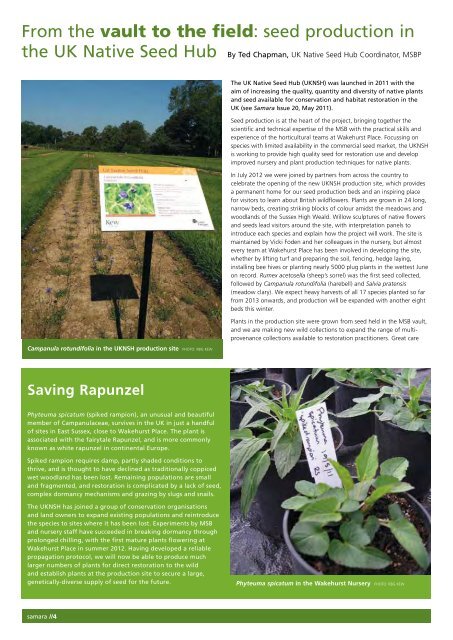A successful partnership between seed banking and horticulture:
A successful partnership between seed banking and horticulture:
A successful partnership between seed banking and horticulture:
Create successful ePaper yourself
Turn your PDF publications into a flip-book with our unique Google optimized e-Paper software.
From the vault to the field: <strong>seed</strong> production in<br />
the UK Native Seed Hub By Ted Chapman, UK Native Seed Hub Coordinator, MSBP<br />
Campanula rotundifolia in the UKNSH production site PHOTO: RBG KEW<br />
The UK Native Seed Hub (UKNSH) was launched in 2011 with the<br />
aim of increasing the quality, quantity <strong>and</strong> diversity of native plants<br />
<strong>and</strong> <strong>seed</strong> available for conservation <strong>and</strong> habitat restoration in the<br />
UK (see Samara Issue 20, May 2011).<br />
Seed production is at the heart of the project, bringing together the<br />
scientific <strong>and</strong> technical expertise of the MSB with the practical skills <strong>and</strong><br />
experience of the horticultural teams at Wakehurst Place. Focussing on<br />
species with limited availability in the commercial <strong>seed</strong> market, the UKNSH<br />
is working to provide high quality <strong>seed</strong> for restoration use <strong>and</strong> develop<br />
improved nursery <strong>and</strong> plant production techniques for native plants.<br />
In July 2012 we were joined by partners from across the country to<br />
celebrate the opening of the new UKNSH production site, which provides<br />
a permanent home for our <strong>seed</strong> production beds <strong>and</strong> an inspiring place<br />
for visitors to learn about British wildflowers. Plants are grown in 24 long,<br />
narrow beds, creating striking blocks of colour amidst the meadows <strong>and</strong><br />
woodl<strong>and</strong>s of the Sussex High Weald. Willow sculptures of native flowers<br />
<strong>and</strong> <strong>seed</strong>s lead visitors around the site, with interpretation panels to<br />
introduce each species <strong>and</strong> explain how the project will work. The site is<br />
maintained by Vicki Foden <strong>and</strong> her colleagues in the nursery, but almost<br />
every team at Wakehurst Place has been involved in developing the site,<br />
whether by lifting turf <strong>and</strong> preparing the soil, fencing, hedge laying,<br />
installing bee hives or planting nearly 5000 plug plants in the wettest June<br />
on record. Rumex acetosella (sheep’s sorrel) was the first <strong>seed</strong> collected,<br />
followed by Campanula rotundifolia (harebell) <strong>and</strong> Salvia pratensis<br />
(meadow clary). We expect heavy harvests of all 17 species planted so far<br />
from 2013 onwards, <strong>and</strong> production will be exp<strong>and</strong>ed with another eight<br />
beds this winter.<br />
Plants in the production site were grown from <strong>seed</strong> held in the MSB vault,<br />
<strong>and</strong> we are making new wild collections to exp<strong>and</strong> the range of multiprovenance<br />
collections available to restoration practitioners. Great care<br />
Saving Rapunzel<br />
Phyteuma spicatum (spiked rampion), an unusual <strong>and</strong> beautiful<br />
member of Campanulaceae, survives in the UK in just a h<strong>and</strong>ful<br />
of sites in East Sussex, close to Wakehurst Place. The plant is<br />
associated with the fairytale Rapunzel, <strong>and</strong> is more commonly<br />
known as white rapunzel in continental Europe.<br />
Spiked rampion requires damp, partly shaded conditions to<br />
thrive, <strong>and</strong> is thought to have declined as traditionally coppiced<br />
wet woodl<strong>and</strong> has been lost. Remaining populations are small<br />
<strong>and</strong> fragmented, <strong>and</strong> restoration is complicated by a lack of <strong>seed</strong>,<br />
complex dormancy mechanisms <strong>and</strong> grazing by slugs <strong>and</strong> snails.<br />
The UKNSH has joined a group of conservation organisations<br />
<strong>and</strong> l<strong>and</strong> owners to exp<strong>and</strong> existing populations <strong>and</strong> reintroduce<br />
the species to sites where it has been lost. Experiments by MSB<br />
<strong>and</strong> nursery staff have succeeded in breaking dormancy through<br />
prolonged chilling, with the first mature plants flowering at<br />
Wakehurst Place in summer 2012. Having developed a reliable<br />
propagation protocol, we will now be able to produce much<br />
larger numbers of plants for direct restoration to the wild<br />
<strong>and</strong> establish plants at the production site to secure a large,<br />
genetically-diverse supply of <strong>seed</strong> for the future.<br />
Phyteuma spicatum in the Wakehurst Nursery PHOTO: RBG KEW<br />
samara //4
















